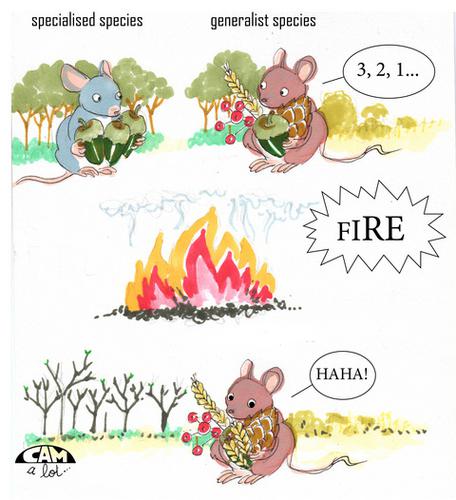当前位置:
X-MOL 学术
›
Austral Ecol.
›
论文详情
Our official English website, www.x-mol.net, welcomes your feedback! (Note: you will need to create a separate account there.)
Rodent assemblage composition as indicator of fire severity in a protected area of south‐central Chile
Austral Ecology ( IF 1.5 ) Pub Date : 2020-12-20 , DOI: 10.1111/aec.12975 Alfredo H. Zúñiga 1, 2, 3 , Jaime R. Rau 1 , Fabián M. Jaksic 3 , Pablo M. Vergara 4 , Francisco Encina‐Montoya 5 , Andrés Fuentes‐Ramírez 6, 7, 8
Austral Ecology ( IF 1.5 ) Pub Date : 2020-12-20 , DOI: 10.1111/aec.12975 Alfredo H. Zúñiga 1, 2, 3 , Jaime R. Rau 1 , Fabián M. Jaksic 3 , Pablo M. Vergara 4 , Francisco Encina‐Montoya 5 , Andrés Fuentes‐Ramírez 6, 7, 8
Affiliation

|
Fires have a considerable impact on biological communities and ecosystems, within which the assessment of burned habitats requires consideration of indicator species or assemblages useful for monitoring. The short‐term effects of fires can be easily deduced from analysing assemblages of animals with short generation times and high fertility rates, such as rodents. Here, we evaluated the effect of fire severity in a protected area of southern Chile on abundance, composition and diversity of rodent assemblages. We sampled rodents and vegetation variables during summer and fall over two years (2017 and 2018) in forest stands with different levels of fire severity (high, low and unburned stands). Changes in diversity and abundance were found between unburned and burned stands, with these differences being more noticeable during the fall of the first year. Abundances of rodent species exhibited marked fluctuations over the study period, but two species consistently decreased their abundances as fire severity increased, and with the absence of one species in burned stands. The adverse fire effects were less evident during the second year due to the overall low capture rates (1.3–1.9%). Rodent species were differently affected by fire, with Irenomys tarsalis (arboreal rat) being the species most sensitive to fires. The effect of fire severity on abundance of rodent species was associated with changes in the vegetation variables, where dead wood, canopy and herb cover showed a low correlation (R = 0.147). Our results suggest that fires of high severity cause important disturbances on habitat and food resources that result in short‐term effects on the rodent assemblage. Fires apparently act as an ecological filter for the more specialised species while offering an opportunity for the settlement of generalist species. Hence, the monitoring of rodent species differing in their ecological traits, such as food habits and space use, offers an opportunity for assessing the short‐term recovery patterns of wildlife after fire disturbances.
中文翻译:

鼠类组合物组成,指示智利中南部保护区的火灾严重性
火灾对生物群落和生态系统有相当大的影响,在其中评估烧毁的栖息地需要考虑对监测有用的指示物种或组合。通过分析具有短生成时间和高生育率的动物(例如啮齿动物)的组合,可以轻松推断出火灾的短期影响。在这里,我们评估了智利南部保护区火灾严重程度对啮齿类动物种群数量,组成和多样性的影响。我们在夏季和秋季的两年(2017年和2018年)中,对森林火灾等级不同(高,低和未燃烧林分)的啮齿动物和植被变量进行了采样。在未燃烧和已燃烧林分之间发现了多样性和丰度的变化,在第一年秋天,这些差异更加明显。在研究期间,啮齿动物物种的丰度表现出明显的波动,但是随着火灾严重程度的增加,两种物种持续降低其丰度,而烧毁的林分中没有一种物种。由于总体捕获率较低(1.3–1.9%),第二年的不良火灾影响不太明显。啮齿动物受到火灾的影响不同,Irenomys tarsalis(树栖鼠)是对火最敏感的物种。火灾严重程度对啮齿动物物种数量的影响与植被变量的变化有关,其中死木,树冠和草本植物的覆盖率显示出较低的相关性(R = 0.147)。我们的结果表明,严重的大火会对栖息地和食物资源造成重大干扰,对啮齿类动物的组合造成短期影响。火灾显然为更专业的物种充当了生态过滤器,同时为定居者提供了机会。因此,对啮齿动物物种的生态特征(例如饮食习惯和空间使用)不同的监测,为评估火灾后野生动植物的短期恢复模式提供了机会。
更新日期:2020-12-20
中文翻译:

鼠类组合物组成,指示智利中南部保护区的火灾严重性
火灾对生物群落和生态系统有相当大的影响,在其中评估烧毁的栖息地需要考虑对监测有用的指示物种或组合。通过分析具有短生成时间和高生育率的动物(例如啮齿动物)的组合,可以轻松推断出火灾的短期影响。在这里,我们评估了智利南部保护区火灾严重程度对啮齿类动物种群数量,组成和多样性的影响。我们在夏季和秋季的两年(2017年和2018年)中,对森林火灾等级不同(高,低和未燃烧林分)的啮齿动物和植被变量进行了采样。在未燃烧和已燃烧林分之间发现了多样性和丰度的变化,在第一年秋天,这些差异更加明显。在研究期间,啮齿动物物种的丰度表现出明显的波动,但是随着火灾严重程度的增加,两种物种持续降低其丰度,而烧毁的林分中没有一种物种。由于总体捕获率较低(1.3–1.9%),第二年的不良火灾影响不太明显。啮齿动物受到火灾的影响不同,Irenomys tarsalis(树栖鼠)是对火最敏感的物种。火灾严重程度对啮齿动物物种数量的影响与植被变量的变化有关,其中死木,树冠和草本植物的覆盖率显示出较低的相关性(R = 0.147)。我们的结果表明,严重的大火会对栖息地和食物资源造成重大干扰,对啮齿类动物的组合造成短期影响。火灾显然为更专业的物种充当了生态过滤器,同时为定居者提供了机会。因此,对啮齿动物物种的生态特征(例如饮食习惯和空间使用)不同的监测,为评估火灾后野生动植物的短期恢复模式提供了机会。



























 京公网安备 11010802027423号
京公网安备 11010802027423号